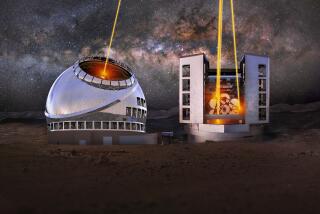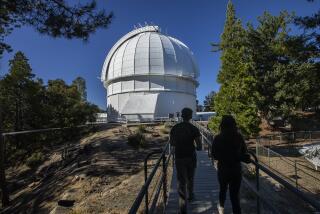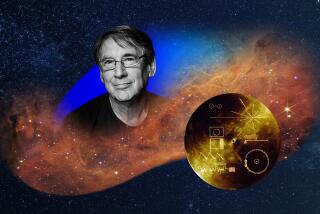How the Hubble Space Telescope has changed our view of the universe
- Share via
Among the pillars and valleys of a nebula 20,000 light-years from Earth, a stellar nursery of glowing gas and dust nurtures thousands of baby stars. This cosmic fireworks display comes to Earth courtesy of the Hubble Space Telescope, which celebrates its 25th anniversary in space on Friday.
Since its launch on April 24, 1990, the telescope has helped us discover the age of the universe, how planets come to be and the fact that most galaxies have their very own supermassive black hole. In 1998, astrophysicists used Hubble to figure out that the universe is not only expanding but accelerating – and they won the Nobel Prize in physics as a result.
Hubble has made more than 1.2 million observations and generated 100 terabytes of data, all while whirling around the Earth at 17,000 mph.
Without Hubble, astronomy “would be an awful lot poorer a field,” said Mike Garcia, a program scientist for Hubble at NASA headquarters in Washington. “The Hubble images capture the beauty of the heavens in a way that nothing else has done. The pictures are works of art, and nothing else has done that.”
Garcia, who has worked on NASA projects for over 30 years, has used the satellite’s images to study black holes in the Andromeda galaxy.
“Hubble found out that there’s a supermassive black hole in the center of every galaxy. And that was a surprise,” Garcia said. “The black holes and the galaxies know about each other. The size of the black hole is in lockstep with the size of the galaxy.”
Hubble doesn’t just stare into deep space; the telescope is just as good at observing objects closer to home. Hubble has provided scientists with images of Pluto’s four moons and photographic evidence that Jupiter’s Great Red Spot has been shrinking, as well as treating viewers to the fragments of a comet crashing into the gas planet.
Garcia’s favorite Hubble image captures the Andromeda galaxy’s nucleus, 2 million light-years away, which is actually pretty close.
“It’s a double nucleus, which is really rare. And it surrounds a supermassive black hole,” Garcia said. “Only an astronomer would love it. It’s not an image the public would go wild over.”
But there are plenty of images the public has gone wild over. Hubble images are embedded in our culture – seen in frames on walls, on computer screen savers and postage stamps.
“An image captures people’s imaginations right away,” said John Trauger, a senior scientist at the Jet Propulsion Laboratory in La Cañada-Flintridge. “Hubble has really helped the idea of communicating science.”
Trauger helped process one of Hubble’s most recognizable images, featuring a dying star throwing dust back into space. “MyCn18,” an hourglass-shaped nebula with a green eye-like center, was photographed in 1996 and made the cover of both National Geographic and the Pearl Jam album “Binaural.”
“I bought the album,” Trauger said. “I haven’t even listened to it, but I thought they did a nice job of using Hubble images.”
Trauger was also the principal investigator of JPL’s mission to repair Hubble after it was launched with a flaw that rendered all its instruments “unfocusable.” In 1993, Space Shuttle Endeavour installed a new camera, called Wide Field Planetary Camera 2, giving us a view into the deepest regions of space. The camera was replaced again with a third version in 2009.
With Hubble, scientists can see the same amount of detail in objects 10 times farther than they would be able to get from a land-based observatory. That allows humans to view a region of space 1,000 times larger than what we can see from the ground, Trauger said.
The Hubble Deep Field image tested the limits of Hubble’s vision. For 10 days, the telescope took pictures of the darkest region of space.
Where nothing could be seen before, Hubble found 4,000 new galaxies. If you were to hold a grain of sand at arms length to the sky, that’s the size of the Deep Field, Trauger said.
It was “kind of a Rosetta stone back to the beginning of galaxies, all in that area of space that had not been explored before,” he said.
Hubble’s quest to capture the universe in images has benefited Earthlings in other ways, too. As NASA and the military push for more advanced digital camera technologies, those improvements eventually find their way into our pocket-sized devices.
“NASA needs cameras that work really well in low light,” Garcia said. “My first cellphone camera worked [poorly] in low light, and now [my new one] works much better.”
Twenty-five years after its launch and six years after its last servicing mission, Hubble is at its scientific peak of productivity, Garcia said: “It just hit its stride.”
NASA expects the satellite to work well in to the 2020s. By 2037, the agency estimates atmospheric drag will start to take its toll. Then they’ll think about boosting it up or bringing it back, Garcia said.
Follow me on Twitter @seangreene89 and “like” Los Angeles Times Science & Health on Facebook.







